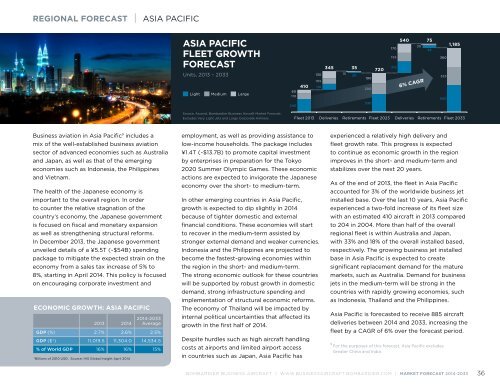Bombardier-Aerospace-20140716-Business-Aircraft-Market-Forecast_2014-33
Bombardier-Aerospace-20140716-Business-Aircraft-Market-Forecast_2014-33
Bombardier-Aerospace-20140716-Business-Aircraft-Market-Forecast_2014-33
Create successful ePaper yourself
Turn your PDF publications into a flip-book with our unique Google optimized e-Paper software.
REGIONAL FORECAST | ASIA PACIFIC<br />
ASIA PACIFIC<br />
FLEET GROWTH<br />
FORECAST<br />
Units, 2013 – 20<strong>33</strong><br />
Light Medium Large<br />
60<br />
110<br />
240<br />
410<br />
130<br />
105<br />
110<br />
345<br />
15<br />
35<br />
20<br />
190<br />
200<br />
<strong>33</strong>0<br />
720<br />
170<br />
155<br />
215<br />
540<br />
30<br />
6% CAGR<br />
75<br />
45<br />
1,185<br />
360<br />
325<br />
500<br />
Source: Ascend, <strong>Bombardier</strong> <strong>Business</strong> <strong>Aircraft</strong> <strong>Market</strong> <strong>Forecast</strong>.<br />
Excludes Very Light Jets and Large Corporate Airliners. Fleet 2013 Deliveries Retirements Fleet 2023 Deliveries Retirements Fleet 20<strong>33</strong><br />
<strong>Business</strong> aviation in Asia Pacific 9 includes a<br />
mix of the well-established business aviation<br />
sector of advanced economies such as Australia<br />
and Japan, as well as that of the emerging<br />
economies such as Indonesia, the Philippines<br />
and Vietnam.<br />
The health of the Japanese economy is<br />
important to the overall region. In order<br />
to counter the relative stagnation of the<br />
country’s economy, the Japanese government<br />
is focused on fiscal and monetary expansion<br />
as well as strengthening structural reforms.<br />
In December 2013, the Japanese government<br />
unveiled details of a ¥5.5T (~$54B) spending<br />
package to mitigate the expected strain on the<br />
economy from a sales tax increase of 5% to<br />
8%, starting in April <strong>2014</strong>. This policy is focused<br />
on encouraging corporate investment and<br />
ECONOMIC GROWTH: ASIA PACIFIC<br />
GDP (%)<br />
GDP ($*)<br />
% of World GDP<br />
2013 <strong>2014</strong><br />
<strong>2014</strong>-20<strong>33</strong><br />
Average<br />
2.7% 2.6% 2.5%<br />
11,019.5 11,304.0 14,534.5<br />
16% 16% 15%<br />
*Billions of 2010 USD. Source: IHS Global Insight April <strong>2014</strong><br />
employment, as well as providing assistance to<br />
low-income households. The package includes<br />
¥1.4T (~$13.7B) to promote capital investment<br />
by enterprises in preparation for the Tokyo<br />
2020 Summer Olympic Games. These economic<br />
actions are expected to invigorate the Japanese<br />
economy over the short- to medium-term.<br />
In other emerging countries in Asia Pacific,<br />
growth is expected to dip slightly in <strong>2014</strong><br />
because of tighter domestic and external<br />
financial conditions. These economies will start<br />
to recover in the medium-term assisted by<br />
stronger external demand and weaker currencies.<br />
Indonesia and the Philippines are projected to<br />
become the fastest-growing economies within<br />
the region in the short- and medium-term.<br />
The strong economic outlook for these countries<br />
will be supported by robust growth in domestic<br />
demand, strong infrastructure spending and<br />
implementation of structural economic reforms.<br />
The economy of Thailand will be impacted by<br />
internal political uncertainties that affected its<br />
growth in the first half of <strong>2014</strong>.<br />
Despite hurdles such as high aircraft handling<br />
costs at airports and limited airport access<br />
in countries such as Japan, Asia Pacific has<br />
experienced a relatively high delivery and<br />
fleet growth rate. This progress is expected<br />
to continue as economic growth in the region<br />
improves in the short- and medium-term and<br />
stabilizes over the next 20 years.<br />
As of the end of 2013, the fleet in Asia Pacific<br />
accounted for 3% of the worldwide business jet<br />
installed base. Over the last 10 years, Asia Pacific<br />
experienced a two-fold increase of its fleet size<br />
with an estimated 410 aircraft in 2013 compared<br />
to 204 in 2004. More than half of the overall<br />
regional fleet is within Australia and Japan,<br />
with <strong>33</strong>% and 18% of the overall installed based,<br />
respectively. The growing business jet installed<br />
base in Asia Pacific is expected to create<br />
significant replacement demand for the mature<br />
markets, such as Australia. Demand for business<br />
jets in the medium-term will be strong in the<br />
countries with rapidly growing economies, such<br />
as Indonesia, Thailand and the Philippines.<br />
Asia Pacific is forecasted to receive 885 aircraft<br />
deliveries between <strong>2014</strong> and 20<strong>33</strong>, increasing the<br />
fleet by a CAGR of 6% over the forecast period.<br />
9 For the purposes of this forecast, Asia Pacific excludes<br />
Greater China and India.<br />
BOMBARDIER BUSINESS AIRCRAFT | WWW.BUSINESSAIRCRAFT.BOMBARDIER.COM | MARKET FORECAST <strong>2014</strong>-20<strong>33</strong> 36


